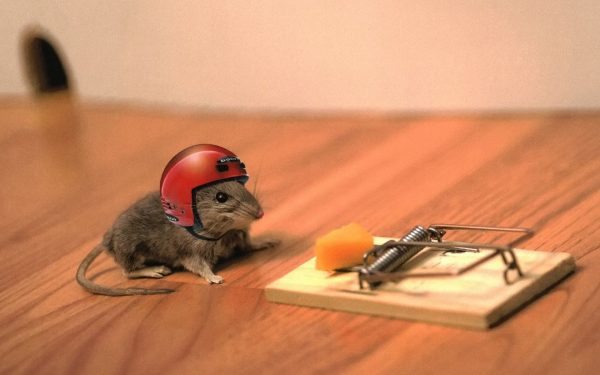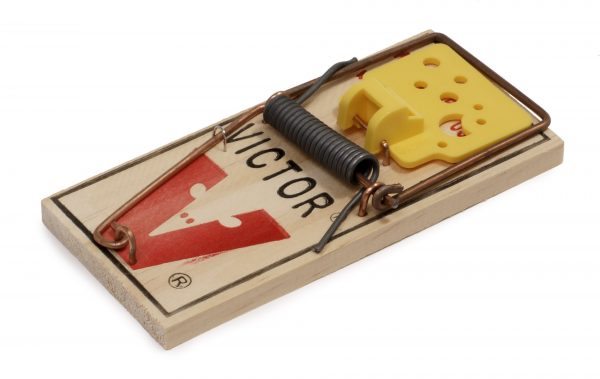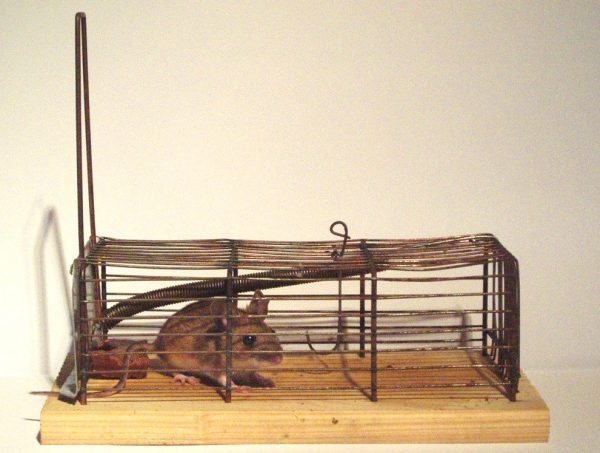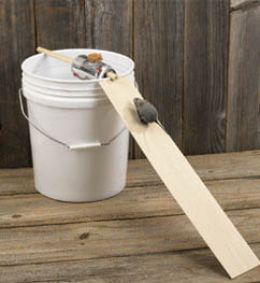The Different Types Of Mouse Traps Explained
There are many ways to deal with a mouse infestation including poison, repellents, and the most common method: mouse traps. There is good reason for this, as mouse traps can be very effective if used correctly (here’s what to do if they are not working for you!).
But why kind of mouse trap should you use? If you’ve ever tried to buy one, you will have noticed that there are many different types, and they each have pros and cons.
This is why we’ve put together this guide on the different types of mouse traps available to you. It will help you decide which type of trap is best for your particular situation.
Snap Mouse Traps
This is the classic mouse trap that people are the most familiar with it. If a cartoon shows a mouse trap, it is almost guaranteed to be a snap trap!
Typically made with a wooden base (sometimes plastic), featuring a spring-loaded metal bar which “snaps” down upon activation by the mouse, either trapping or killing it instantly. The bait is placed on a pressure sensitive switch which causes the trap to activate when the mouse tries to move it.
Snap traps are considered cruel by some, as they can severely injure the mouse but fall short of killing it, causing unnecessary suffering.
Read the review of our favorite snap mouse trap here.
Pros
- Cheap
- Effective if used properly
- Most can be reused many times
Cons
- Can be difficult to set, due to sensitivity of activation switch
- Considered cruel by some
Electronic Mouse Traps
A relatively new introduction to the world of rodent control, electronic mouse traps are becoming very popular for their easy of use and effectiveness.
These work by luring the mouse inside where a lethal electric shock is delivered, killing the mouse in just a few seconds. A buzzing sound may be heard when the mouse is being electrocuted, if you are close enough. The device is designed in such a way as to protect humans and pets from being shocked.
There are electric mouse traps, and also larger electric rat traps.
Electronic mouse traps come in both single and multi use varieties, with varying prices of course. Most electronic traps run on standard AA batteries, and have green and red lights for indicating a captured mouse and low battery, respectively.
Pros
- Quick, humane kill
- Easy to set (no fussing with pressure sensitive triggers!)
- Can dispose of mouse without having to see or touch it
Cons
- More expensive, if you have few rodents
- Kills mouse, no chance of live release
Glue Mouse Traps
Glue mouse traps are the simplest types of traps, usually with no moving or mechanical parts. It’s pretty much just like the name would indicate, a sticky adhesive traps the mouse on a board (usually cardboard or plastic) and prevents it from escaping.
These are some of the most controversial mouse traps, and are thought to be cruel by many people. This is because they often do not kill the mouse, unless it is left long enough to die of starvation. Despite not killing the rodent, a live release is sometimes not possible because it is difficult to remove the mouse from the adhesive without severe injury. Vegetable oil, canola oil, olive oil, or even baby oil can be used with varying degrees of effectiveness.
Glue traps do not work well outdoors, as environmental conditions (rain, excessive humidity) will render the adhesive ineffective.
Bait is typically used, although is is also possible to capture mice in glue traps without the use of bait. For instance, one common tactic is to place glue traps next to traditional snap or electronic traps. The mice tend to want to jump over them, and will land directly in the glue.
The adhesive is non-toxic to humans and pets, although pets may inadvertently come into contact with it and get the trap stuck to them. In such cases, vegetable oil can be used to loosen the trap and slowly work it free.
Pros
- Inexpensive
- Very easy to set up
- Effective is used properly, even without bait
- Can dispose of mouse without touching it
Cons
- Considered by many to be cruel and inhumane
- Single use only
- Live release often not possible
- Must be kept away from pets and small children
Live-Catch Mouse Traps
Some live-catch traps are similar to traps for larger mammals; essentially cages with trigger-activated doors which close and lock the mouse inside. One such trap is pictured to the left.
Click here to view our best humane mouse trap review.
There are too many variations of live-capture traps to cover them all here, but one of the most common ones, because of is ease of use, is the bucket trap.
Bucket Mouse Traps
One of the most basic do-it-yourself live-capture mouse traps is the bucket trap.
Consisting of a 5-gallon bucket with a ramp leading up to it. Over the top of the bucket will be a soda can pierced through long ways with a rod or piece of wire. This is done so that bait can be placed in the can, which will rotate and cause the mouse to fall into the bucket.
This trap can be made lethal by placing a poison in the bucket, such as antifreeze. The antifreeze has the added benefit of acting as an embalming agent, preventing the mouse from decomposing and creating a foul odor.
Bucket traps can capture many mice (10+) before needing to be replaced or cleaned, adding to their cost efficiency.
Pros
- Relatively easy to build yourself, using common household materials
- Inexpensive
- Many live traps are multi-capture
- Reusable
- Allows for live release
Cons
- Larger, take up more space
- If capturing live, must deal with live mice
- Mice which are released may find their way back to your home
Common Brands Of Mouse Trap
There are many brands of mouse trap on the market, and most are available at any major retailer that sells general goods or any hardware store.
Here are some of the more well known and trusted brands to look out for.
- Victor
- Nooski
- D-Con
- Woodstream
- Catchmaster
- Pic
- Ortho Home Defense
- Tomcat
- JT Eaton
- Kness
- Bonide
Which Type Of Mouse Trap Should You Use?
The type of trap that you should use depends entirely on your specific situation and conditions.
Are your mice indoors or outdoors? Do you want to capture them live or dead? Do you have pets or small children which could taper with traps? How many mice are you dealing with?
All of these questions must be answered when choosing a trap, although if used properly ANY type of trap can get rid of the mice you are trying to eliminate.
The Best Bait For Mouse Traps
Although the cartoon idea of using cheese in a mouse trap is (mostly) a myth, there are several household items which can be used to lure mice into a trap.
The most widely used bait is peanut butter, and that’s because it works!
Bird seed and pet food can also work.
Sugary treats also work well, such as marshmallows, gum drops, maple syrup, or chocolate.
If you can identify what the mice in your house are eating, you can simply eliminate all other sources of it and place some in the trap. They will have no choice but to go for it!
Another option is to forget about food, and use nesting material as bait. Mice will always go for things such as dental floss or other bits of string.
Non Toxic Spray
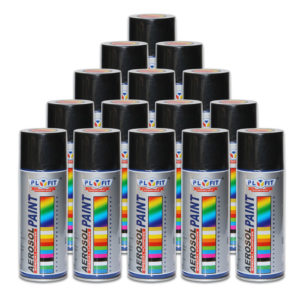
This non-toxic spray kills larvae, eggs, and adult insects by breaking down their exoskeleton. It is safe to spray around the home and works only on the insects. Feel good about spraying indoors around pets, plants and children.
All Natural Non Toxic Insect Killer Spray by Killer Green

